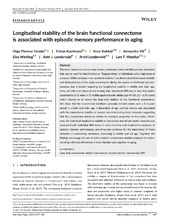| dc.contributor.author | Ousdal, Olga Therese | |
| dc.contributor.author | Kaufmann, Tobias | |
| dc.contributor.author | Kolskår, Knut-Kristian | |
| dc.contributor.author | Vik, Alexandra | |
| dc.contributor.author | Wehling, Eike | |
| dc.contributor.author | Lundervold, Astri | |
| dc.contributor.author | Lundervold, Arvid | |
| dc.contributor.author | Westlye, Lars Tjelta | |
| dc.date.accessioned | 2020-08-12T08:54:12Z | |
| dc.date.available | 2020-08-12T08:54:12Z | |
| dc.date.issued | 2020 | |
| dc.Published | Ousdal OT, Kaufmann T, Kolskår K, Vik A, Wehling EI, Lundervold AJ, Lundervold A, Westlye LT. Longitudinal stability of the brain functional connectome is associated with episodic memory performance in aging. Human Brain Mapping. 2020;41(3):697-709 | eng |
| dc.identifier.issn | 1065-9471 | |
| dc.identifier.issn | 1097-0193 | |
| dc.identifier.uri | https://hdl.handle.net/1956/23674 | |
| dc.description.abstract | The brain functional connectome forms a relatively stable and idiosyncratic backbone that can be used for identification or “fingerprinting” of individuals with a high level of accuracy. While previous cross‐sectional evidence has demonstrated increased stability and distinctiveness of the brain connectome during the course of childhood and adolescence, less is known regarding the longitudinal stability in middle and older age. Here, we collected structural and resting‐state functional MRI data at two time points separated by 2–3 years in 75 middle‐aged and older adults (age 49–80, SD = 6.91 years) which allowed us to assess the long‐term stability of the functional connectome. We show that the connectome backbone generally remains stable over a 2–3 years period in middle and older age. Independent of age, cortical volume was associated with the connectome stability of several canonical resting‐state networks, suggesting that the connectome backbone relates to structural properties of the cortex. Moreover, the individual longitudinal stability of subcortical and default mode networks was associated with individual differences in cross‐sectional and longitudinal measures of episodic memory performance, providing new evidence for the importance of these networks in maintaining mnemonic processing in middle and old age. Together, the findings encourage the use of within‐subject connectome stability analyses for understanding individual differences in brain function and cognition in aging. | en_US |
| dc.language.iso | eng | eng |
| dc.publisher | Wiley | eng |
| dc.rights | Attribution-NonCommercial-NoDerivs CC BY-NC-ND | eng |
| dc.rights.uri | http://creativecommons.org/licenses/by-nc-nd/4.0/ | eng |
| dc.title | Longitudinal stability of the brain functional connectome is associated with episodic memory performance in aging | eng |
| dc.type | Peer reviewed | |
| dc.type | Journal article | |
| dc.date.updated | 2020-01-28T10:00:42Z | |
| dc.description.version | publishedVersion | |
| dc.rights.holder | Copyright 2019 The Author(s) | eng |
| dc.identifier.doi | https://doi.org/10.1002/hbm.24833 | |
| dc.identifier.cristin | 1755763 | |
| dc.source.journal | Human Brain Mapping | |

